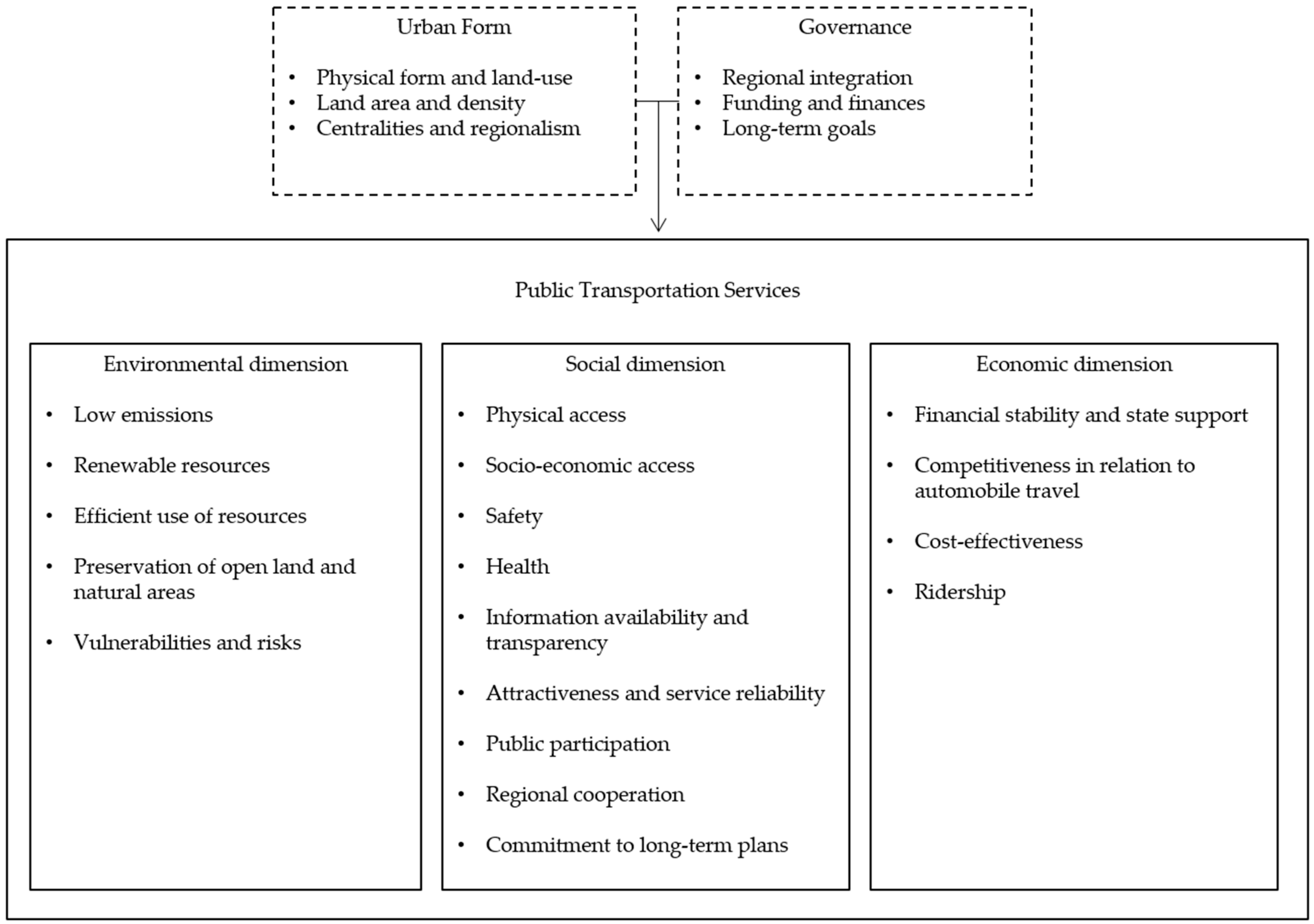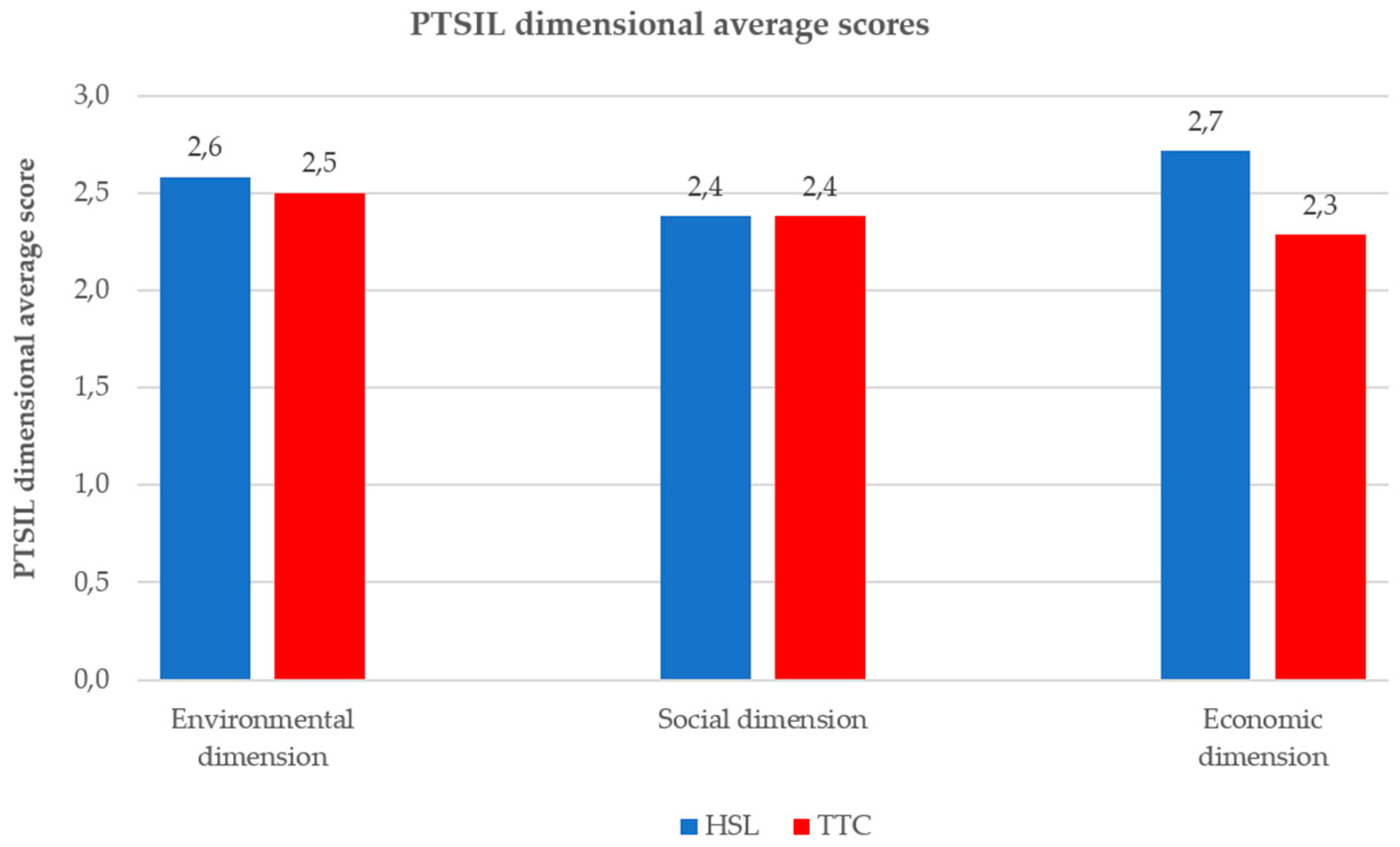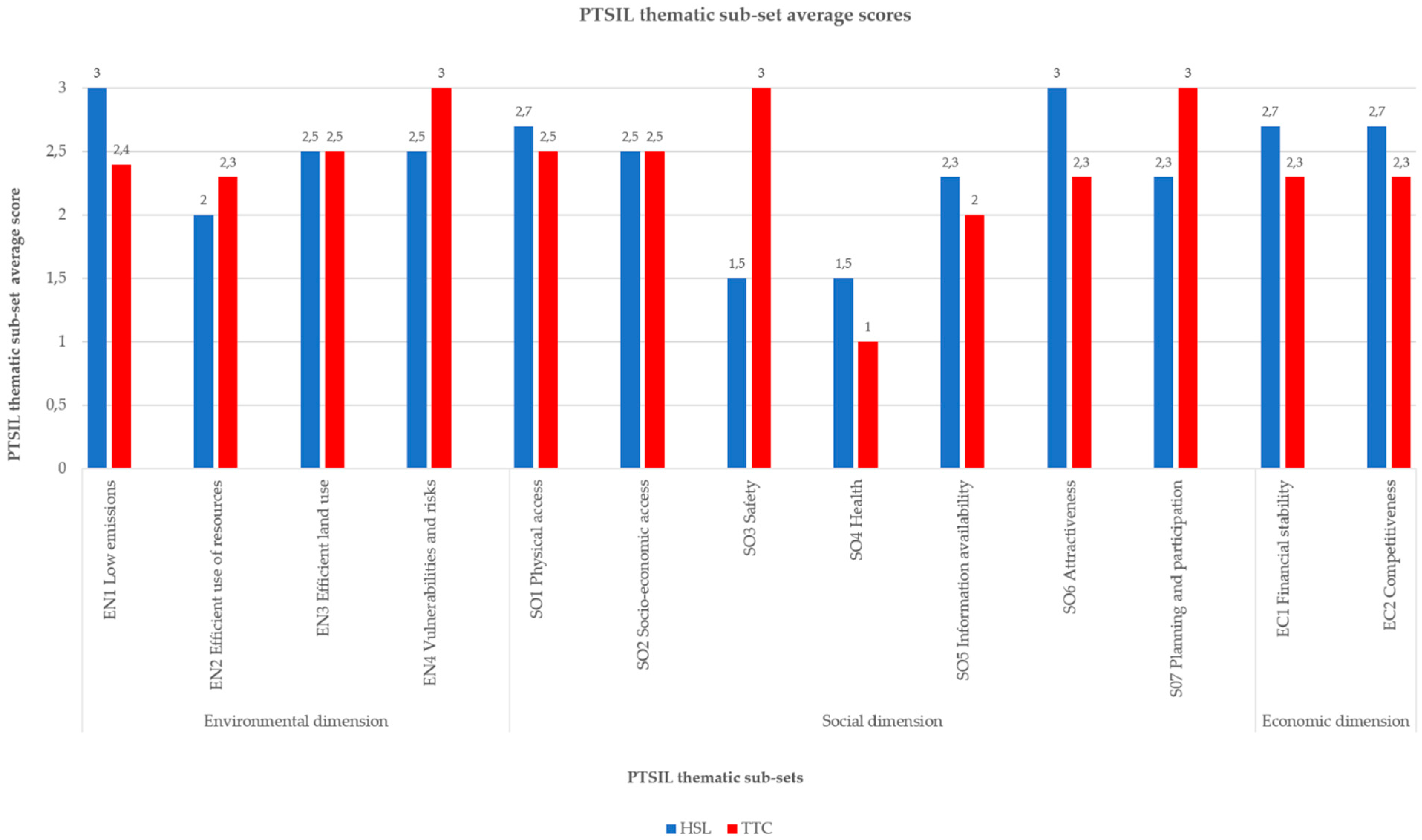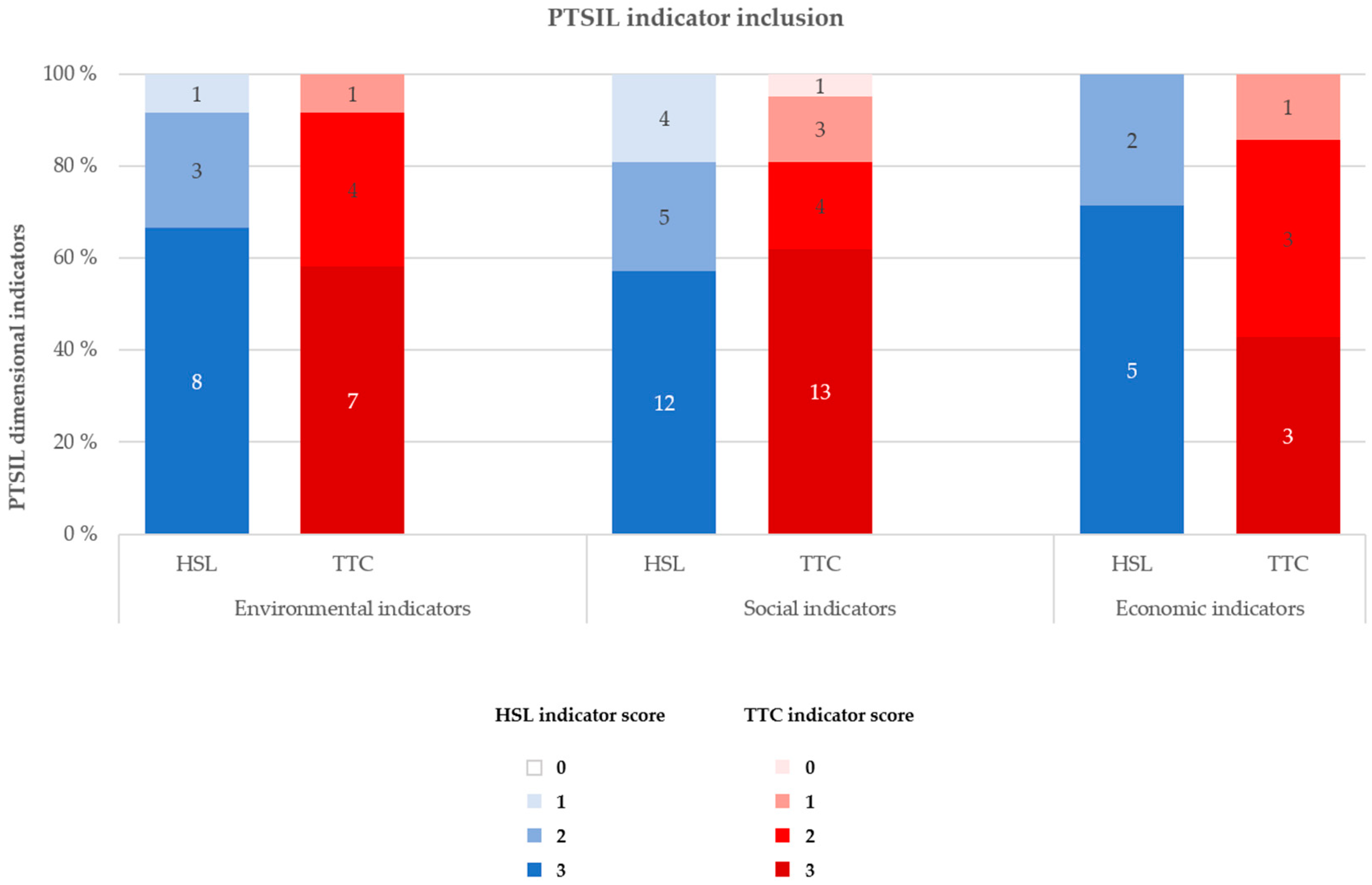Framework for Assessing Public Transportation Sustainability in Planning and Policy-Making
Abstract
1. Introduction
2. Assessing Public Transportation Sustainability
2.1. Previous Assessments in Literature
2.2. Analytical Framework
2.2.1. Environmental Sustainability
2.2.2. Social Sustainability
2.2.3. Economic Sustainability
3. Materials and Methods
3.1. Indicator Selection Criteria
3.2. Public Transportation Sustainability Indicator List (PTSIL)
3.3. Applying Qualitative Content Analysis as a Method
- 0 = (Not included)
- 1 = Public transportation produces GHG emissions.
- 2 = GHG emissions will be reduced.
- 3 = GHG emissions will be reduced by 50% by 2020 (from 1990 level).
3.4. Case Approach
3.4.1. Helsinki and the HSL
3.4.2. Toronto and the TTC
3.5. Data
3.6. Coding Reliability and Methodological Limitations
4. Results
4.1. HSL Results
4.2. TTC Results
5. Discussion and Conclusions
Supplementary Materials
Author Contributions
Funding
Acknowledgments
Conflicts of Interest
References
- United Nations. World Urbanization Prospects: The 2014 Revision (ST/ESA/SER.A/366); United Nations, Department of Economic and Social Affairs, Population Division: New York, NY, USA, 2014; Available online: https://esa.un.org/unpd/wup/Publications/Files/WUP2014-Report.pdf (accessed on 1 October 2016).
- Jeon, C.M.; Amekudzi, A. Addressing Sustainability in Transportation Systems: Definitions, Indicators, and Metrics. J. Infrastruct. Syst. 2005, 11, 31–50. [Google Scholar] [CrossRef]
- Banister, D. Sustainable Urban Development and Transport—A Eurovision for 2020. Transp. Rev. 2000, 20, 113–130. [Google Scholar] [CrossRef]
- Pardo, C.F.; Jiemian, Y.; Hongyuan, Y.; Mohanty, C.R. Sustainable urban transport. In United Nations, Department of Economic and Social Affairs (UNDESA), Shanghai Manual—A Guide for Sustainable Urban Development in the 21st Century; The Commercial Press Ltd.: Beijing, China, 2012; pp. 1–36. Available online: https://sustainabledevelopment.un.org/content/documents/shanghaimanual.pdf (accessed on 5 October 2016).
- Schiller, P.L.; Bruun, E.C.; Kenworthy, J.R. An Introduction to Sustainable Transportation: Policy, Planning, and Implementation; Earthscan Ltd.: London, UK, 2010. [Google Scholar]
- Wheeler, S.M. Planning for Metropolitan Sustainability. J. Plan. Educ. Res. 2000, 20, 133–145. [Google Scholar] [CrossRef]
- Wheeler, S.M.; Beatley, T. Sustainable Urban Development Reader, 3rd ed.; Routledge: Abingdon, UK, 2014. [Google Scholar]
- Brundtland, G.H.; WCED. Our Common Future (Report of the World Commission on Environment and Development); Oxford University: Oxford, UK, 1987. [Google Scholar]
- Bickel, P.; Ahvenharju, S.; Könnölä, T.; Hjelt, M.; De Tommasi, R.; Arend, M.; Röhling, W.; Burg, R. SUMMA: Deliverable 2 of Workpackage 1: Setting the Context for Defining Sustainable Transport and Mobility. 2003. Available online: http://www.tmleuven.be/project/summa/summa-d2.pdf (accessed on 5 February 2017).
- Goldman, T.; Gorham, R. Sustainable Urban Transport: Four Innovative Directions. Technol. Soc. 2006, 28, 261–273. [Google Scholar] [CrossRef]
- Hull, A. Policy Integration: What Will it Take to Achieve More Sustainable Transport Solutions in Cities? Transp. Policy 2008, 15, 94–103. [Google Scholar] [CrossRef]
- Litman, T.; Burwell, D. Issues in Sustainable Transportation. Int. J. Glob. Environ. Issues 2006, 6, 331–347. [Google Scholar] [CrossRef]
- Marsden, G.; Kimble, M.; Nellthorp, J.; Kelly, C. Sustainability Assessment: The Definition Deficit. Int. J. Sustain. Transp. 2010, 4, 189–211. [Google Scholar] [CrossRef]
- Miller, P.; de Barros, A.G.; Kattan, L.; Wirasinghe, S.C. Public Transportation and Sustainability: A Review. Ksce J. Civ. Eng. 2016, 20, 1076–1083. [Google Scholar] [CrossRef]
- De Gruyter, C.; Currie, G.; Rose, G. Sustainability Measures of Urban Public Transport in Cities: A World Review and Focus on the Asia/Middle East Region. Sustainability 2017, 9, 43. [Google Scholar] [CrossRef]
- Litman, T. Developing Indicators for Comprehensive and Sustainable Transport Planning. Transp. Res. Rec. J. Transp. Res. Board 2007, 2017, 10–15. [Google Scholar] [CrossRef]
- Olofsson, Z.; Hiselius, L.; Várhelyi, A. Development of a tool to assess urban transport sustainability: The case of Swedish cities. Int. J. Sustain. Transp. 2016, 10, 645–656. [Google Scholar] [CrossRef]
- Chow, J.Y.J.; Hernandez, S.; Bhagat, A.; McNally, M.G. Multi-Criteria Sustainability Assessment in Transport Planning for Recreational Travel. Int. J. Sustain. Transp. 2013, 8, 151–175. [Google Scholar] [CrossRef]
- Danielis, R.; Rotaris, L.; Monte, A. Composite indicators of sustainable urban mobility: Estimating the rankings frequency distribution combining multiple methodologies. Int. J. Sustain. Transp. 2018, 12, 380–395. [Google Scholar] [CrossRef]
- Maheshwari, P.; Kachroo, P.; Paz, A.; Khaddar, R. Development of control models for the planning of sustainable transportation systems. Transp. Res. Part C 2015, 55, 474–485. [Google Scholar] [CrossRef]
- Miller, P.; de Barros, A.G.; Kattan, L.; Wirasinghe, S.C. Analyzing the Sustainability Performance of Public Transit. Transp. Res. Part D 2016, 44, 177–198. [Google Scholar] [CrossRef]
- Ramani, T.; Zietsman, J.; Gudmundsson, H.; Hall, R.; Marsden, G. Framework for Sustainability Assessment by Transportation Agencies. Transp. Res. Rec. J. Transp. Res. Board 2011, 2242, 9–18. [Google Scholar] [CrossRef]
- Boschmann, E.E.; Kwan, M.-P. Toward Socially Sustainable Urban Transportation: Progress and Potentials. Int. J. Sustain. Transp. 2008, 2, 138–157. [Google Scholar] [CrossRef]
- Murray, A.T.; Davis, R.; Stimson, R.J.; Ferreira, L. Public Transportation Access. Transp. Res. Part D 1998, 3, 319–328. [Google Scholar] [CrossRef]
- Banister, D. Cities, mobility and climate change. J. Transp. Geogr. 2011, 19, 1538–1546. [Google Scholar] [CrossRef]
- Dell’Olio, L.; Ibeas, A.; Cecin, P. The Quality of Service Desired by Public Transport Users. Transp. Policy 2011, 18, 217–227. [Google Scholar] [CrossRef]
- Næss, P. New Urbanism’ or Metropolitan-level Centralization? A Comparison of the Influences of Metropolitan-level and Neighborhood-level Urban Form Characteristics on Travel Behavior. J. Transp. Land Use 2011, 4, 25–44. [Google Scholar]
- Atkinson, G.; Oleson, T. Urban sprawl as a path dependent process. J. Econ. Issues 1996, 30, 609–615. [Google Scholar] [CrossRef]
- May, A. Urban Transport and Sustainability: The Key Challenges. Int. J. Sustain. Transp. 2013, 7, 170–185. [Google Scholar] [CrossRef]
- Newman, P.; Kenworthy, J. Cities and Automobile Dependence: An International Sourcebook; Gower Publishing: Aldershot, UK, 1989. [Google Scholar]
- Nijkamp, P.; Ouwersloot, H.; Rienstra, S.A. Sustainable Urban Transport Systems: An Expert-based Strategic Scenario Approach. Urban Stud. 1997, 34, 693–712. [Google Scholar] [CrossRef]
- Rodrigue, J.-P.; Comtois, C.; Slack, B. The Geography of Transport Systems; Routledge: Oxford, UK, 2006. [Google Scholar]
- Kennedy, C.; Miller, E.; Shalaby, A.; Maclean, H.; Coleman, J. The Four Pillars of Sustainable Urban Transportation. Transp. Rev. 2005, 25, 393–414. [Google Scholar] [CrossRef]
- Richardson, B.C. Sustainable Transport: Analysis Frameworks. J. Transp. Geogr. 2005, 13, 29–39. [Google Scholar] [CrossRef]
- Environmental Protection Agency. Guide to Sustainable Transportation Performance Measures (EPA Publication No. 231-K-10-004). 2011. Available online: https://www.epa.gov/sites/production/files/2014-01/documents/sustainable_ transpo_performance.pdf (accessed on 16 November 2016).
- Walker, W.E.; van Grol, R.; Rahman, S.A.; van de Voort, M.; Röhling, W.; Burg, R. Policy Analysis of Sustainable Tranport and Mobility: The SUMMA Project. In Building Blocks for Sustainable Transport: Obstacles, Trends, Solutions; Perrels, A., Himanen, A., Lee-Gosselin, M., Eds.; Emerald Group Publishing Limited: Bingley, UK, 2007; pp. 225–272. [Google Scholar]
- Kenworthy, J.R. Sustainable Urban Transport: Developing Sustainability Rankings and Clusters based on International Comparisons of Cities. In Handbook of Sustainability Research; Filho, W.L., Ed.; Peter Lang: Frankfurt, Germany, 2005; pp. 409–437. [Google Scholar]
- Dobranskyte-Niskota, A.; Perujo, A.; Pregl, M. Indicators to Assess Sustainability of Transport Activities Part 1: Review of the Existing Transport Sustainability Indicators Initiatives and Development of an Indicator Set to Assess Transport Sustainability Performance (Report). European Commission. 2007. Available online: https://publications.europa.eu/en/publication-detail/-/publication/ba11f7f1-368b-464f-987f-3e571be6f678/language-en (accessed on 1 September 2016).
- Solecki, W.; Rosenzweig, C.; Hammer, S.; Mehrotra, S. The Urbanization of Climate Change: Responding to a New Global Challenge. In Sustainable Urban Development Reader, 3rd ed.; Wheeler, S.M., Beatley, T., Eds.; Routledge: Abingdon, UK, 2013; pp. 107–116. [Google Scholar]
- Shen, L.-Y.; Ochoa, J.; Shah, M.N.; Zhang, X. The Application of Urban Sustainability Indicators—A Comparison between Various Practices. Habitat Int. 2011, 35, 17–29. [Google Scholar] [CrossRef]
- Hertel, S.; Keil, R.; Collens, M. Next Stop: Equity—Routes to Fairer Transit Access in the Greater Toronto and Hamilton Area. 2016. Available online: http://city.apps01.yorku.ca/wpcontent/uploads/2016/02/Transit-Equity_Reduced_020216.pdf (accessed on 10 November 2016).
- Swyngedouw, E.; Heynen, N.C. Urban Political Ecology, Justice and the Politics of Scale. Antipode 2003, 34, 898–918. [Google Scholar] [CrossRef]
- Garrett, M.; Taylor, B. Reconsidering Social Equity in Public Transit. Berkeley Plan. J. 1999, 13, 6–27. [Google Scholar]
- Sanchez, T.W. Poverty, Policy, and Public Transportation. Transp. Res. Part A 2008, 42, 833–841. [Google Scholar] [CrossRef]
- Sanchez, T.W.; Wolf, J.F. Environmental Justice and Transportation Equity: A Review of Metropolitan Planning Organizations (Paper to be presented at the Racial Equity in Transportation: Establishing Priorities for Research and Policy roundtable sponsored by the Civil Rights Project at Harvard). Available online: https://www.researchgate.net/profile/Thomas_Sanchez/publication/230820724_Environmental_justice_and_transportation_equity_A_review_of_metropolitan_planning_organizations/links/0fcfd50b5a04eda5a4000000.pdf (accessed on 5 September 2016).
- Murray, A.T.; Davis, R. Equity in Regional Service Provision. J. Reg. Sci. 2001, 41, 577–600. [Google Scholar] [CrossRef]
- Fellesson, M.; Friman, M. Perceived Satisfaction with Public Transport Service in Nine European Cities. J. Transp. Res. Forum 2008, 47, 93–103. [Google Scholar] [CrossRef]
- OECD. Towards Sustainable Transportation (OECD Proceedings—The Vancouver Conference 1996, March 24–27th). Available online: http://www.oecd.org/greengrowth/greening-transport/2396815.pdf (accessed on 10 November 2016).
- Cervero, R. Transit pricing research: A review and synthesis. Transportation 1990, 17, 117–139. [Google Scholar] [CrossRef]
- Haghshenas, H.; Vaziri, M. Urban Sustainable Transportation Indicators for Global Comparison. Ecol. Indic. 2012, 15, 115–121. [Google Scholar] [CrossRef]
- Krippendorff, K. Content Analysis: An Introduction to its Methodology; Sage Publications Ltd.: London, UK, 2004. [Google Scholar]
- Neuendorf, K.A. The Content Analysis Guidebook; Sage Publications: Thousand Oaks, CA, USA, 2002. [Google Scholar]
- Metsämuuronen, J. Tutkimuksen Tekemisen Perusteet Ihmistieteissä; Gummerus Kirjapaino Oy: Jyväskylä, Finland, 2009. [Google Scholar]
- HSL. HSL Vuosikertomus 2015. Available online: https://www.hsl.fi/sites/default/files/hsl_vuosikertomus_fi_2015_aukeamat_1.pdf (accessed on 10 November 2016).
- TTC. System Map. Available online: http://www.ttc.ca/PDF/Maps/TTC_SystemMap.pdf (accessed on 1 November 2016).
- HSL. HSL liikuttaa meitä kaikkia. Available online: https://www.hsl.fi/sites/default/files/uploads/hsl_liikuttaa_meita_kaikkia_0.pdf (accessed on 10 November 2016).
- HSL. HSL Perussopimus. Available online: https://www.hsl.fi/sites/default/files/uploads/hsl_perussopimus.pdf (accessed on 10 November 2016).
- Helsingin kaupunki. Helsingin Yleiskaava. Available online: http://www.hel.fi/hel2/ksv/julkaisut/yos_2016-3.pdf (accessed on 20 January 2017).
- Helsingin kaupunki. Joukkoliikenteen runkoverkko 2050. Available online: http://www.hel.fi/hel2/ksv/Liitteet/2016_kaava/Yleiskaava_joukkoliikenteen_runkoverkko_20160614.pdf (accessed on 20 January 2017).
- HSL. Helsingin seudun liikennejärjestelmäsuunnitelma HLJ 2015. Available online: https://www.hsl.fi/sites/default/files/uploads/2015-03-03-hlj_2015-raportti.pdf (accessed on 10 November 2016).
- HSL. Matkan pituus näkymään lipun hinnassa entistä selvemmin. Available online: https://www.hsl.fi/taksa-ja-lippujarjestelma (accessed on 30 January 2017).
- HSL. HSL:n hallitus hyväksyi sopimusmallin matkaketjuyhteistyöstä. Available online: https://www.hsl.fi/uutiset/2016/hsln-hallitushyvaksyi-sopimusmallin-matkaketjuyhteistyosta-9317 (accessed on 20 January 2017).
- HSL. Digitalisation to Enable More Freedom of Choice in Transport. Available online: https://www.hsl.fi/en/news/2015/digitalisation-enablemore-freedom-choice-transport-6052 (accessed on 20 January 2017).
- HSL. HLJ 2015 Joukkoliikennestrategia. Available online: https://www.hsl.fi/sites/default/files/uploads/joukkoliikennestrategia_hlj2015_raportti.pdf (accessed on 10 November 2016).
- HSL. HLJ 2015:n nykytilatarkastelu (NYYTTI). Available online: https://www.hsl.fi/sites/default/files/ uploads/nykytilatarkastelu_nyytti_hlj2015_raportti.pdf (accessed on 10 November 2016).
- City of Toronto. Toronto Transit Commission (TTC)—Board Governance Structure. Available online: http://www1.toronto.ca/wps/portal/contentonly?vgnextoid=c773811db1704410VgnVCM10000071d60f89RCRD (accessed on 25 January 2017).
- Metrolinx. The Big Move—Transforming Transportation in the Greater Toronto and Hamilton Area. Available online: http://www.metrolinx.com/thebigmove/Docs/big_move/TheBigMove_020109.pdf (accessed on 20 November 2016).
- City of Toronto. Toronto Official Plan. Available online: http://www1.toronto.ca/planning/chapters1-5.pdf (accessed on 25 January 2017).
- TTC. Five Year Corporate Plan 2013–2017. Available online: https://www.ttc.ca/PDF/TTC_Corporate-Plan_Accessible_v2.pdf (accessed on 1 November 2016).
- Kennedy, C. A Comparison of the Sustainability of Public and Private Transportation Systems: Study of the Greater Toronto Area. Transportation 2002, 29, 459–493. [Google Scholar] [CrossRef]
- Miller, E.J.; Shalaby, A. Evolution of Personal Travel in Toronto Area and Policy Implications. J. Urban Plan. Dev. 2003, 129, 1–26. [Google Scholar] [CrossRef]
- Toronto Foundation. Toronto’s Vital Signs 2015 Report. Available online: http://2015.torontosvitalsigns.ca/sites/default/files/OP-TVS%202015-Full-Report-PRINTING.pdf (accessed on 10 April 2016).
- HSL. HSL:n joukkoliikenteen asiakastyytyväisyystutkimus, syksy 2015. Available online: https://www.hsl.fi/sites/default/files/uploads/7_2016_asty_syksy_2015.pdf (accessed on 10 November 2016).
- HSL. Joukkoliikenteen suunnitteluohje HSL-liikenteessä 2016. Available online: https://www.hsl.fi/sites/default/files/uploads/joukkoliikenteen_suunnitteluohje_hsl-liikenteessa_2016.pdf (accessed on 10 November 2016).
- HSL. Viisas liikkuminen: Kestävät liikkumisvalinnat. Available online: https://www.hsl.fi/sites/default/files/00_viisas_liikkuminen_helsingin_seutu_tietopaketti_hsl.pdf (accessed on 12 November 2016).
- HSL. Ympäristöraportti. Available online: https://www.hsl.fi/sites/default/files/uploads/ hsl_ymparistoraportti_2014.pdf (accessed on 11 November 2016).
- HSL. HSL Toimintastrategia 2025 ja tausta-aineisto. Available online: https://www.hsl.fi/sites/default/files/uploads/hsl_toimintastrategia.pdf; https://www.hsl.fi/sites/default/files/uploads/hsl_toimintastrategia_tausta_aineisto.pdf (accessed on 10 November 2016).
- HSL. HSL:n laatu-ja ympäristöpolitiikka. Available online: ttps://www.hsl.fi/sites/default/files/uploads/hsl_laatu_ja_ymparistopolitiikka.pdf (accessed on 10 November 2016).
- TTC. 2016 TTC Accessibility Plan Status Report. Available online: https://www.ttc.ca/About_the_TTC/Commission_reports_and_information/Commission_meetings/2016/February_25/Reports/2016_Accessibility_Plan_Status_Report_BR_17780_V2.pdf (accessed on 1 November 2016).
- TTC. TTC Chief Executive Officer’s Report—May 2016 Update. Available online: https://www.ttc.ca/About_the_TTC/CEO_Report/index.jsp (accessed on 1 November 2016).
- TTC. TTC Annual Report 2015. Available online: https://www.ttc.ca/PDF/About_the_TTC/Annual_Reports/TTC_2015AnnualReport_AODA_FINAL-s.pdf (accessed on 1 November 2016).
- TTC. 2014-2018 TTC Multi-Year Accessibility Plan. Available online: http://www.toronto.ca/legdocs/mmis/2014/di/bgrd/backgroundfile-70029.pdf (accessed on 1 November 2016).
- TTC. TTC Customer Satisfaction Survey—2013 Results. Available online: https://www.ttc.ca/PDF/Customer_Service/Board_Presentation_on_Customer_Satisfaction_Survey_2013_Q1-Q.pdf (accessed on 1 November 2016).
- TTC. TTC Environmental Plan—Initiatives and Implementation. Available online: https://www.ttc.ca/About_the_TTC/Commission_reports_and_information/Commission_meetings/2007/Dec_6_2007/Other/TTC_Environmental_Pl.pdf (accessed on 1 November 2016).
- TTC. TTC Ridership Growth Strategy. Available online: https://www.ttc.ca/PDF/Transit_Planning/ridership_growth_strategy_2003.pdf (accessed on 1 November 2016).
- TTC. TTC Sustainability Report 2013. Available online: http://www.ttc.ca/PDF/About_the_TTC/Sustainability_Reports/2013_Sustainability_Report.PDF (accessed on 1 November 2016).
- City of Toronto. Toward a Policy Framework for Toronto Transit Fare Equity. Available online: https://www.toronto.ca/legdocs/mmis/2014/ex/bgrd/backgroundfile-70755.pdf (accessed on 1 November 2016).
- Metrolinx. 2015–2020 Metrolinx Five Year Strategy. Available online: http://www.metrolinx.com/en/aboutus/publications/Metrolinx_Five_Year_Strategy_2015-2020_EN.pdf (accessed on 20 November 2016).
- Keil, R.; Young, D. Transportation: The Bottleneck of Regional Competitiveness in Toronto. Environ. Plan. C: Gov. Policy 2008, 26, 728–751. [Google Scholar] [CrossRef]
- Hatzopoulou, M.; Miller, E.J. Institutional Integration for Sustainable Transportation Policy in Canada. Transp. Policy 2008, 15, 149–162. [Google Scholar] [CrossRef]
- Statistics Canada. 2011 Census of Population: Toronto, Ontario (Code 3520005) and Ontario (Code 35) (Table), Statistics Canada Catalogue No. 98-316-XWE, Ottawa. Available online: https://www12.statcan.gc.ca/census-recensement/2011/dp-pd/prof/details/page.cfm?Lang=E&Geo1=CSD&Code1=3520005&Geo2=PR&Code2=35&Data=Count&SearchText=Toronto&SearchType=Begins&SearchPR=01&B1=All&GeoLevel=PR&GeoCode=3520005 (accessed on 15 November 2016).
- Suomen virallinen tilasto. Väestörakenne (ISSN=1797-5379). Helsinki: Tilastokeskus. Available online: http://www.stat.fi/tup/alue/kuntienavainluvut.html#?year=2016&active1=091 (accessed on 16 December 2016).




| Criterion | Explanation |
|---|---|
| Target relevance | Indicator must show one aspect of sustainable transportation |
| Data availability and measurability | Indicators must be measurable with chosen data |
| Validity | Indicators must measure the issue it is supposed to measure |
| Sensitivity | Indicator must be able to reveal sustainable transport changes |
| Transparency | Indicators should be feasible to understand and possible to reproduce |
| Independent | Indicators should be independent of each other |
| Standardized | Indicators should be standardized by city size for comparison |
| Environmental Sustainability | |
| EN1 Low emissions | EN1-1 GHG emissions (↓) |
| EN1-2 Air pollution (PM, NOx, SOx, O3) (↓) | |
| EN1-3 Noise pollution (↓) | |
| EN1-4 Use of renewable energy (↑) | |
| EN1-5 Use of innovative technology (↑) | |
| EN2 Efficient use of resources | EN2-1 Emissions per passenger (↓) |
| EN2-2 Efficient energy use (↑) | |
| EN2-3 Amount of waste (↓) | |
| EN3 Efficient land use | EN3-1 Preservation of open land and natural areas (↑) |
| EN3-2 Transit oriented development (↑) | |
| EN4 Vulnerabilities and risks | EN4-1 Vulnerability and risk assessment (↑) |
| EN4-2 Vulnerability and risk contingency (↑) | |
| Social Sustainability | |
| SO1 Physical access | SO1-1 Proximity to service (↑) |
| SO1-2 Service frequency (↑) | |
| SO1-3 Travel time (↓) | |
| SO1-4 Multi-modality (↑) | |
| SO1-5 Inter-modality (↑) | |
| SO1-6 Access with disabilities (↑) | |
| SO2 Socio-economic access | SO2-1 Share of income used on PT (↓) |
| SO2-2 Attention to the elderly, young, and low-income (↑) | |
| SO3 Safety | SO3-1 Traffic accidents and injuries (↓) |
| SO3-2 Feeling of safety (↑) | |
| SO4 Health | SO4-1 Improved environmental health (↑) |
| SO4-2 Improved individual health (↑) | |
| SO5 Information availability | SO5-1 Timely service information available (↑) |
| SO5-2 Personal journey planner available (↑) | |
| SO5-3 Transparency in decision-making (↑) | |
| SO6 Attractiveness | SO6-1 User satisfaction (↑) |
| SO6-2 Active promotion to non-users (↑) | |
| SO6-2 Service reliability (↑) | |
| SO7 Planning and participation | SO7-1 Public participation (↑) |
| SO7-2 Regional cooperation (↑) | |
| SO7-3 Commitment to long-term plans (↑) | |
| Economic Sustainability | |
| EC1 Financial stability | EC1-1 State funding and subsidies (↑) |
| EC1-2 Fare revenue (↑) | |
| EC1-3 Budget deficit (↓) | |
| EC2 Competitiveness | EC2-1 High ridership (↑) |
| EC2-2 System capacity (↑) | |
| EC2-3 Investment cost-efficiency (↑) | |
| EC2-4 Operating cost-efficiency (↑) | |
| HSL | TTC |
|---|---|
|
|
| Score | HSL | TTC |
|---|---|---|
| 0 | SO5-2 Personal journey planner available (↑) | |
| 1 | EN2-3 Amount of waste (↓) SO3-2 Feeling of safety (↑) SO4-1 Improved environmental health (↑) SO5-3 Transparency in decision-making (↑) SO7-1 Public participation (↑) | EN2-1 Emissions per passenger (↓) SO4-1 Improved environmental health (↑) SO4-2 Improved individual health (↑) SO6-2 Active promotion to non-users (↑) EC2-3 Investment cost-efficiency (↑) |
| 2 | EN2-1 Emissions per passenger (↓) EN3-1 Preservation of open land and natural areas (↑) EN4-1 Vulnerability and risk assessment (↑) SO1-1 Proximity to service (↑) SO1-3 Travel time (↓) SO2-1 Share of income used on PT (↓) SO3-1 Traffic accidents and injuries (↓) SO4-2 Improved individual health (↑) EC1-3 Budget deficit (↓) EC2-2 System capacity (↑) | EN1-1 GHG emissions (↓) EN1-2 Air pollution (PM, NOx, SOx, O3) (↓) EN1-3 Noise pollution (↓) EN3-2 Transit oriented development (↑) SO1-1 Proximity to service (↑) SO1-3 Travel time (↓) SO1-4 Multi-modality (↑) SO2-1 Share of income used on PT (↓) EC1-2 Fare revenue (↑) EC1-3 Budget deficit (↓) EC2-4 Operating cost-efficiency (↑) |
| 3 | EN1-1 GHG emissions (↓) EN1-2 Air pollution (PM, NOx, SOx, O3) (↓) EN1-3 Noise pollution (↓) EN1-4 Use of renewable energy (↑) EN1-5 Use of innovative technology (↑) EN2-2 Efficient energy use (↑) EN3-2 Transit oriented development (↑) EN4-2 Vulnerability and risk contingency (↑) SO1-2 Service frequency (↑) SO1-4 Multi-modality (↑) SO1-5 Inter-modality (↑) SO1-6 Access with disabilities (↑) SO2-2 Attention to the elderly, young, and low-income (↑) SO5-1 Timely service information available (↑) SO5-2 Personal journey planner available (↑) SO6-1 User satisfaction (↑) SO6-2 Active promotion to non-users (↑) SO6-2 Service reliability (↑) SO7-2 Regional cooperation (↑) SO7-3 Commitment to long-term plans (↑) EC1-1 State funding and subsidies (↑) EC1-2 Fare revenue (↑) EC2-1 High ridership (↑) EC2-3 Investment cost-efficiency (↑) EC2-4 Operating cost-efficiency (↑) | EN1-4 Use of renewable energy (↑) EN1-5 Use of innovative technology (↑) EN2-2 Efficient energy use (↑) EN2-3 Amount of waste (↓) EN3-1 Preservation of open land and natural areas (↑) EN4-1 Vulnerability and risk assessment (↑) EN4-2 Vulnerability and risk contingency (↑) SO1-2 Service frequency (↑) SO1-5 Inter-modality (↑) SO1-6 Access with disabilities (↑) SO2-2 Attention to the elderly, young, and low-income (↑) SO3-1 Traffic accidents and injuries (↓) SO3-2 Feeling of safety (↑) SO5-1 Timely service information available (↑) SO5-3 Transparency in decision-making (↑) SO6-1 User satisfaction (↑) SO6-2 Service reliability (↑) SO7-1 Public participation (↑) SO7-2 Regional cooperation (↑) SO7-3 Commitment to long-term plans (↑) EC1-1 State funding and subsidies (↑) EC2-1 High ridership (↑) EC2-2 System capacity (↑) |
© 2019 by the authors. Licensee MDPI, Basel, Switzerland. This article is an open access article distributed under the terms and conditions of the Creative Commons Attribution (CC BY) license (http://creativecommons.org/licenses/by/4.0/).
Share and Cite
Karjalainen, L.E.; Juhola, S. Framework for Assessing Public Transportation Sustainability in Planning and Policy-Making. Sustainability 2019, 11, 1028. https://doi.org/10.3390/su11041028
Karjalainen LE, Juhola S. Framework for Assessing Public Transportation Sustainability in Planning and Policy-Making. Sustainability. 2019; 11(4):1028. https://doi.org/10.3390/su11041028
Chicago/Turabian StyleKarjalainen, Linda E., and Sirkku Juhola. 2019. "Framework for Assessing Public Transportation Sustainability in Planning and Policy-Making" Sustainability 11, no. 4: 1028. https://doi.org/10.3390/su11041028
APA StyleKarjalainen, L. E., & Juhola, S. (2019). Framework for Assessing Public Transportation Sustainability in Planning and Policy-Making. Sustainability, 11(4), 1028. https://doi.org/10.3390/su11041028





